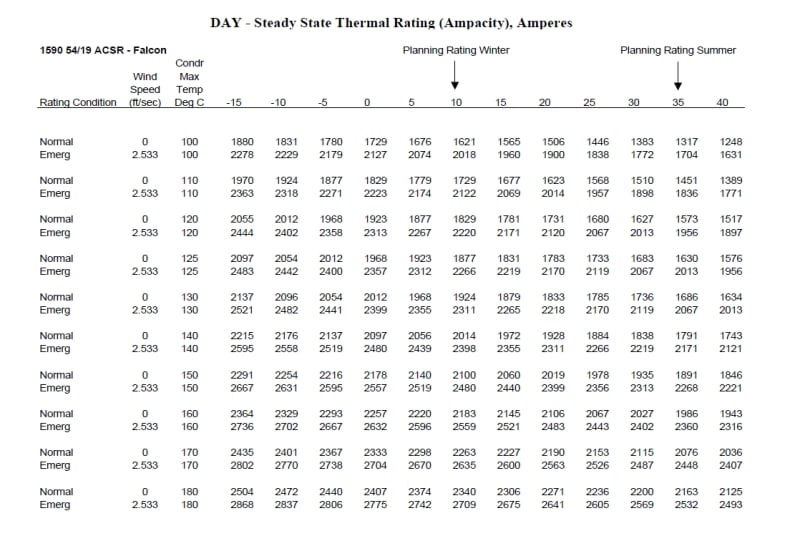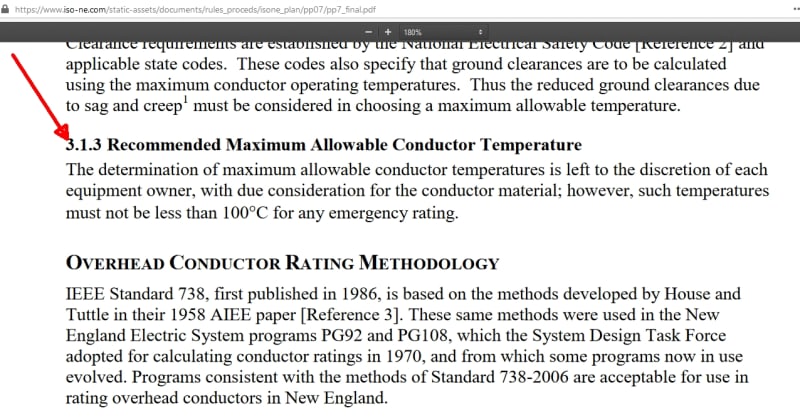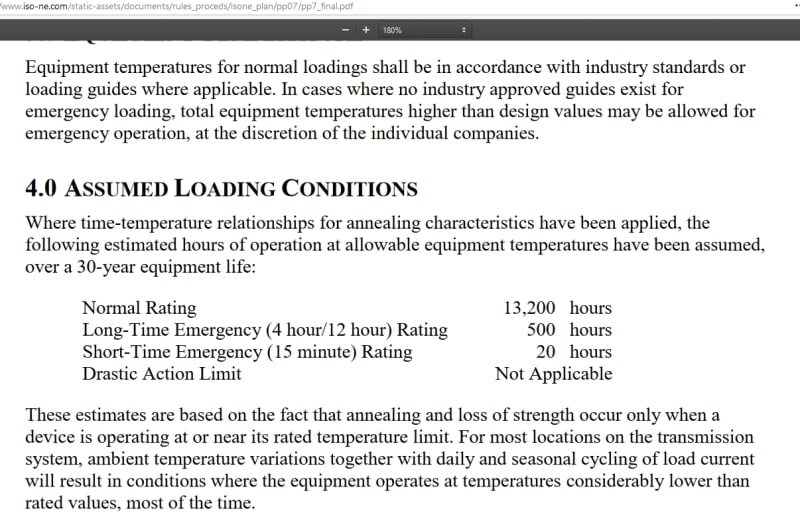Navigation
Install the app
How to install the app on iOS
Follow along with the video below to see how to install our site as a web app on your home screen.
Note: This feature may not be available in some browsers.
More options
Style variation
-
Congratulations TugboatEng on being selected by the Eng-Tips community for having the most helpful posts in the forums last week. Way to Go!
You are using an out of date browser. It may not display this or other websites correctly.
You should upgrade or use an alternative browser.
You should upgrade or use an alternative browser.
Transmission operation above 100*C 2
- Thread starter Mbrooke
- Start date
- Status
- Not open for further replies.
I really don't think an ACSR conductor can be used at 100°C.
Besides the creep problems and mechanical strength, the sag would be excessive.
Typical upper temperature limit values for ACSR conductors (and attendant hardware) are 70 or 75°C.
Clearly, it makes no economic sense to permanently operate an HV line at such high temperature.
To opeate an aluminum / steel conductor at temperatures of 100°C and above, you should use an ACSS conductor and special hardware.
Si duri puer ingeni videtur,
preconem facias vel architectum.
Besides the creep problems and mechanical strength, the sag would be excessive.
Typical upper temperature limit values for ACSR conductors (and attendant hardware) are 70 or 75°C.
Clearly, it makes no economic sense to permanently operate an HV line at such high temperature.
To opeate an aluminum / steel conductor at temperatures of 100°C and above, you should use an ACSS conductor and special hardware.
Si duri puer ingeni videtur,
preconem facias vel architectum.
- Thread starter
- #3
- Thread starter
- #4
From PJM's line rating guide, listing going over 100*C on ACSR:

Typically North American ISOs want emergency ratings to be no less than 100*C:

On the idea that LTE and STE ratings will be limited in duration and frequency relative to the in service life of the equipment:

Thus temps above 100*C can occasionally be encountered in reality and must be taken into account. At least that is what contingency load flows that I'm crunching are telling me.

Typically North American ISOs want emergency ratings to be no less than 100*C:

On the idea that LTE and STE ratings will be limited in duration and frequency relative to the in service life of the equipment:

Thus temps above 100*C can occasionally be encountered in reality and must be taken into account. At least that is what contingency load flows that I'm crunching are telling me.
bacon4life
Electrical
Many utilities use temperature over 100C for emergency ratings. It is very rare to actually operate the line at over 100C. I have seen various utility rules for time limits, but I have never figured out how they actually track lifetime exposure to each temperature.
One of the hardware vendor reps told me that some formulations penetrox will drip out of the joints at around 100C. I have wondered how many utilities do an IR scan of a line after utilizing the emergency ratings of a line.
One of the hardware vendor reps told me that some formulations penetrox will drip out of the joints at around 100C. I have wondered how many utilities do an IR scan of a line after utilizing the emergency ratings of a line.
-
1
- #6
Hello mbrooke,
it is quite strange, to me, to refer to a 30 years operating lifetime: generally a 50 years lifetime is considered here for ACSR conductors (obviously excluding zones close to the sea); we have severeal thousands km of ACSR conductors installed in the '50s or even before.
Indeed you can live with some loss of strength: but you have to take it into account when designing the OHL, mainly increasing the clearances, eventually leading to higher construction cost, visual impact and lightning exposure.
Consider that, for a 31.5 mm ACSR conductor with a 350 m span, the clearance will be reduced of about 1 m when increasing the operating temperature from 70 to 100°C.
So that you have to consider higher clearances to use the conductor at 100°C, both because of the creep and of sag increase: operating an HV transmission line at this temperature is useless in most cases because at 70°C you are already operating the OHL HV line at about 4-5 times the SIL, so that most probably it is not the conductor ampacity to limit the active power flow.
Generally, our practice is to design transmission lines to operate with an average load slightly above the SIL, with an "economical current density" of about 0.6 ÷ 0.7 A/mm2 and, consequently, a very low operating temperature.
Clearances are however evaluated to allow continuous operation at 70 or 75°C (I would define this a LTE).
A further 20% ampacity is allowed, as a rule of thumb, for 15' (I would define this a STE) if the loading was below 80% of the rated ampacity at 70°C, mainly relying on the thermal inertia of the conductor.
it is quite strange, to me, to refer to a 30 years operating lifetime: generally a 50 years lifetime is considered here for ACSR conductors (obviously excluding zones close to the sea); we have severeal thousands km of ACSR conductors installed in the '50s or even before.
Indeed you can live with some loss of strength: but you have to take it into account when designing the OHL, mainly increasing the clearances, eventually leading to higher construction cost, visual impact and lightning exposure.
Consider that, for a 31.5 mm ACSR conductor with a 350 m span, the clearance will be reduced of about 1 m when increasing the operating temperature from 70 to 100°C.
So that you have to consider higher clearances to use the conductor at 100°C, both because of the creep and of sag increase: operating an HV transmission line at this temperature is useless in most cases because at 70°C you are already operating the OHL HV line at about 4-5 times the SIL, so that most probably it is not the conductor ampacity to limit the active power flow.
Generally, our practice is to design transmission lines to operate with an average load slightly above the SIL, with an "economical current density" of about 0.6 ÷ 0.7 A/mm2 and, consequently, a very low operating temperature.
Clearances are however evaluated to allow continuous operation at 70 or 75°C (I would define this a LTE).
A further 20% ampacity is allowed, as a rule of thumb, for 15' (I would define this a STE) if the loading was below 80% of the rated ampacity at 70°C, mainly relying on the thermal inertia of the conductor.
-
1
- #7
bacon4life
Electrical
fpalone-What region are you in? I had not realized anyone was building new transmission lines with clearances for 70C.
Within my region of the USA, utilities are required to operate such that no lines will overload for any N-1 outage as simulated by using a real-time contingency analysis tool. Prior to the requirement for RTCA, many utilities had no documented short term ratings, and instead just assumed equipment could handle short term overloads.
Without high allowable conductor operating temperatures and the use of short term emergency overloads, many of our lines would routinely be loaded well below reasonable operating temperatures. For example consider a pair of parallel lines rated 600A@49C, 1100A@75C, 1400A@100C and 1600A@STE. If we only had a 75C rating, each line would normally operate at 550A@~45C so that total flow would be less than 1100A if one of the lines trips. By having documenting a 1600A short term rating, we can operate the with a total flow of 1600A, meaning each line normally operates at 800A@~60C.
Within my region of the USA, utilities are required to operate such that no lines will overload for any N-1 outage as simulated by using a real-time contingency analysis tool. Prior to the requirement for RTCA, many utilities had no documented short term ratings, and instead just assumed equipment could handle short term overloads.
Without high allowable conductor operating temperatures and the use of short term emergency overloads, many of our lines would routinely be loaded well below reasonable operating temperatures. For example consider a pair of parallel lines rated 600A@49C, 1100A@75C, 1400A@100C and 1600A@STE. If we only had a 75C rating, each line would normally operate at 550A@~45C so that total flow would be less than 1100A if one of the lines trips. By having documenting a 1600A short term rating, we can operate the with a total flow of 1600A, meaning each line normally operates at 800A@~60C.
- Thread starter
- #8
- Status
- Not open for further replies.
Similar threads
- Question
- Replies
- 0
- Views
- 9K
- Question
- Replies
- 8
- Views
- 21K
- Question
- Replies
- 2
- Views
- 4K
- Question
- Replies
- 3
- Views
- 9K
- Question
- Replies
- 22
- Views
- 8K
